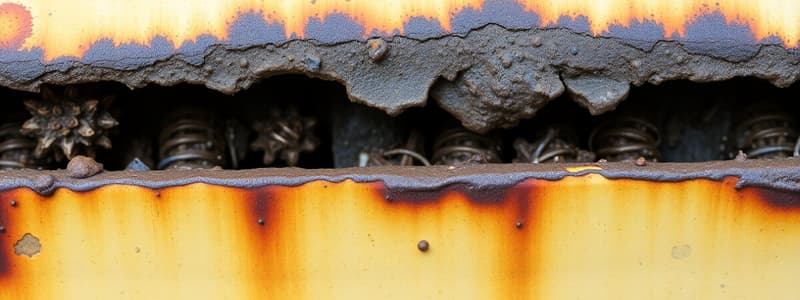Podcast
Questions and Answers
What is a significant factor that contributes to the corrosion resistance of steel pipelines?
What is a significant factor that contributes to the corrosion resistance of steel pipelines?
- Soil composition (correct)
- Water salinity
- Temperature variation
- Pesticide presence
Which mechanism of stress corrosion cracking involves hydrogen reducing the strength of steel?
Which mechanism of stress corrosion cracking involves hydrogen reducing the strength of steel?
- Electrolytic Corrosion
- Anodic Dissolution
- Hydrogen Embrittlement (correct)
- Film Rupture
In which environment is anodic dissolution most likely to accelerate crack propagation in steel?
In which environment is anodic dissolution most likely to accelerate crack propagation in steel?
- Temperate forests
- Freshwater lakes
- Desert regions
- Chloride-containing environments (correct)
What is the primary cause of crack growth in steel during stress corrosion cracking?
What is the primary cause of crack growth in steel during stress corrosion cracking?
Which of the following statements is true regarding the passive oxide film on steel?
Which of the following statements is true regarding the passive oxide film on steel?
What is one major form of external corrosion in steel pipelines?
What is one major form of external corrosion in steel pipelines?
What essential role do pipelines serve in modern energy?
What essential role do pipelines serve in modern energy?
What can lead to internal corrosion in pipelines?
What can lead to internal corrosion in pipelines?
Which of the following is commonly used for analyzing stress distribution in materials?
Which of the following is commonly used for analyzing stress distribution in materials?
What happens during the long-term service of buried pipelines?
What happens during the long-term service of buried pipelines?
What does simulation of stress corrosion cracking help predict?
What does simulation of stress corrosion cracking help predict?
What does the Nernst equation describe in relation to metal ions in a solution?
What does the Nernst equation describe in relation to metal ions in a solution?
What is represented by the dashed lines in a Pourbaix diagram?
What is represented by the dashed lines in a Pourbaix diagram?
In what condition will a metal corrode when placed in an environment?
In what condition will a metal corrode when placed in an environment?
Which model specifically focuses on crack propagation once a crack has initiated?
Which model specifically focuses on crack propagation once a crack has initiated?
What does Corrosion Models predict?
What does Corrosion Models predict?
In the electrochemical reaction for metal oxidation, what happens to the metal?
In the electrochemical reaction for metal oxidation, what happens to the metal?
What is shown between the dashed lines in a Pourbaix diagram?
What is shown between the dashed lines in a Pourbaix diagram?
What primary mechanism is responsible for the deterioration of metals during corrosion?
What primary mechanism is responsible for the deterioration of metals during corrosion?
Which component of the Nernst equation accounts for the temperature dependence of the electrochemical potential?
Which component of the Nernst equation accounts for the temperature dependence of the electrochemical potential?
What is the role of the electrolyte in the corrosion process?
What is the role of the electrolyte in the corrosion process?
Which of the following reactions represents cathodic oxygen reduction in neutral media?
Which of the following reactions represents cathodic oxygen reduction in neutral media?
What is a significant contributor to the high economic cost of corrosion globally?
What is a significant contributor to the high economic cost of corrosion globally?
When modeling SCC, which method is utilized to incorporate the effects of elastic and plastic deformation?
When modeling SCC, which method is utilized to incorporate the effects of elastic and plastic deformation?
What criterion is typically employed in predicting the yielding behavior of materials in SCC modeling?
What criterion is typically employed in predicting the yielding behavior of materials in SCC modeling?
In the corrosion process, what is observed to occur simultaneously with anodic oxidation?
In the corrosion process, what is observed to occur simultaneously with anodic oxidation?
What does Icorr represent in the equation for estimating corrosion rate?
What does Icorr represent in the equation for estimating corrosion rate?
Which of the following factors does NOT affect the calculation of Icorr?
Which of the following factors does NOT affect the calculation of Icorr?
How is the overpotential (η) defined according to the content?
How is the overpotential (η) defined according to the content?
What is the role of Faraday's constant (F) in the corrosion rate equation?
What is the role of Faraday's constant (F) in the corrosion rate equation?
What does the intersection of the anodic and cathodic reactions represent in corrosion studies?
What does the intersection of the anodic and cathodic reactions represent in corrosion studies?
In the Butler-Volmer equation, what does the term $i_{corr}$ represent?
In the Butler-Volmer equation, what does the term $i_{corr}$ represent?
How does the porosity of soil influence corrosion rates of buried structures?
How does the porosity of soil influence corrosion rates of buried structures?
What is indicated by the Tafel slope in corrosion studies?
What is indicated by the Tafel slope in corrosion studies?
Flashcards are hidden until you start studying
Study Notes
Corrosion and its Effects
- Corrosion is the deterioration of metal due to electrochemical reactions with the environment.
- The direct cost of metallic corrosion in the United States was estimated to be 3.1% of the U.S. Gross Domestic Product (GDP) in 2002.
- The global cost of corrosion was estimated to be 3.4% of global GDP in 2013.
- Corrosion requires a conductive solution (electrolyte), an electronic path, an anodic reaction, and a cathodic reaction.
- The anodic reaction is the oxidation of the metal.
- The cathodic reaction is the reduction of an oxidizing agent.
- The rate of the anodic reaction is equal to the rate of the cathodic reaction.
- The metal is oxidized to a metal ion while electrons are released and consumed during the reduction reaction.
- The number of electrons released equals the valence of the metal ions released to the electrolyte.
- The electrochemical series of metals is formed by listing the standard potentials of different metals in ascending or descending order, taking the standard potential of hydrogen as the zero point.
- A metal will corrode if its standard potential is more negative than the standard potential of the coupled cathodic reaction.
- The oxidation reaction can be illustrated using a Pourbaix diagram where the electrochemical potential is plotted vs. the pH of water at 25°C.
- The Pourbaix diagram can be used to identify the electrochemical state of a metal (immunity, actively corroding, or passivity) at a specific pH and potential.
- Corrosion rate can be estimated using Faraday's law: Icorr = nFW/MT, where n is the valence of the metal, F is Faraday's constant (96,500 C.mol¯¹), W is the atomic mass of the metal, M is the mass of corroded metal (g), and T is the time the current was applied (s).
- The potential difference between the corroded metal and a reference electrode is known as the open circuit potential (Eoc) or corrosion potential (Ecorr).
- Overpotential (n) is the deviation of the potential from Eoc when an external current is applied: n=E-Eoc.
- The intersection of the anodic and cathodic reactions in a polarization diagram represents the Eoc/Ecorr and icorr.
Corrosion in Soils
- Soil porosity controls the flow of fluids through the soil, affecting the corrosion of buried structures.
- Coarse-grained soils have higher oxygen permeability, while fine-grained soils have higher water saturation.
- The pH and composition of groundwater in contact with buried structures depends on the soil and climate.
- Chloride concentration is high in desert regions, making the soil very corrosive.
- Soils in tropical climates tend to be very acidic.
- Corrosion resistance of steel pipelines varies depending on soil composition, pH, and moisture content.
Stress Corrosion Cracking (SCC) in Steel
- SCC results from a combination of a susceptible material, a specific chemical species (environment), and tensile stress.
- The mechanism of SCC in steel involves the combined action of tensile stress and a corrosive environment.
- SCC can occur in various environments such as seawater, acidic solutions, or caustic environments.
- Common proposed mechanisms for SCC in steel include:
- Hydrogen embrittlement: Hydrogen diffuses into steel under stress, leading to brittle fracture.
- Anodic dissolution: Aggressive species can cause anodic dissolution at the crack tip, accelerating crack propagation.
- Film rupture and repassivation: Rupture of the passive oxide film formed on the surface of some steels under stress, allowing corrosion.
Studying That Suits You
Use AI to generate personalized quizzes and flashcards to suit your learning preferences.




